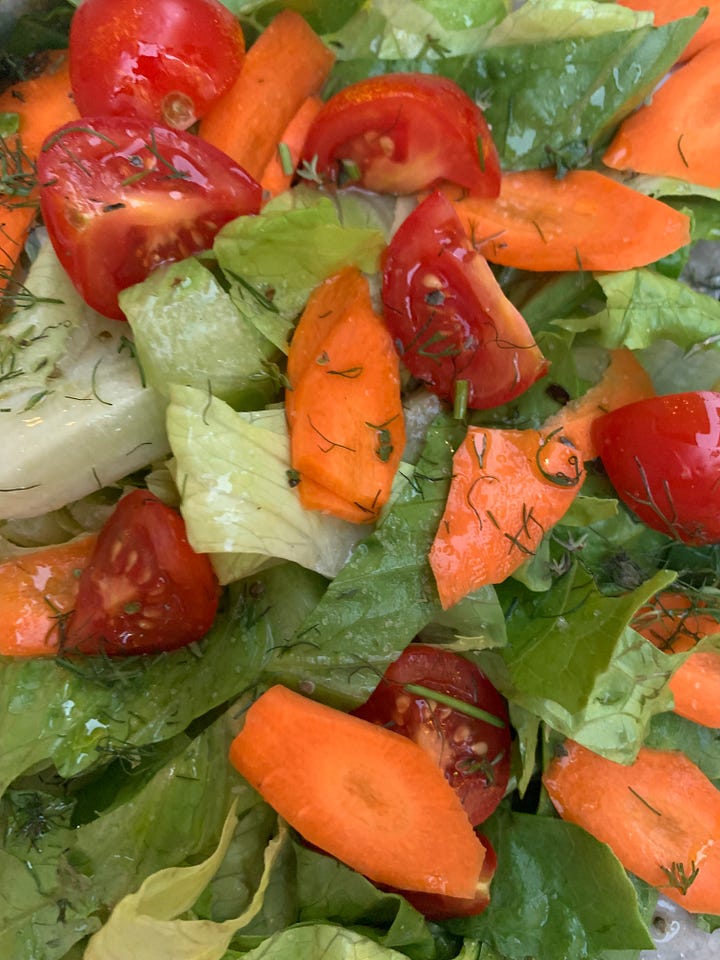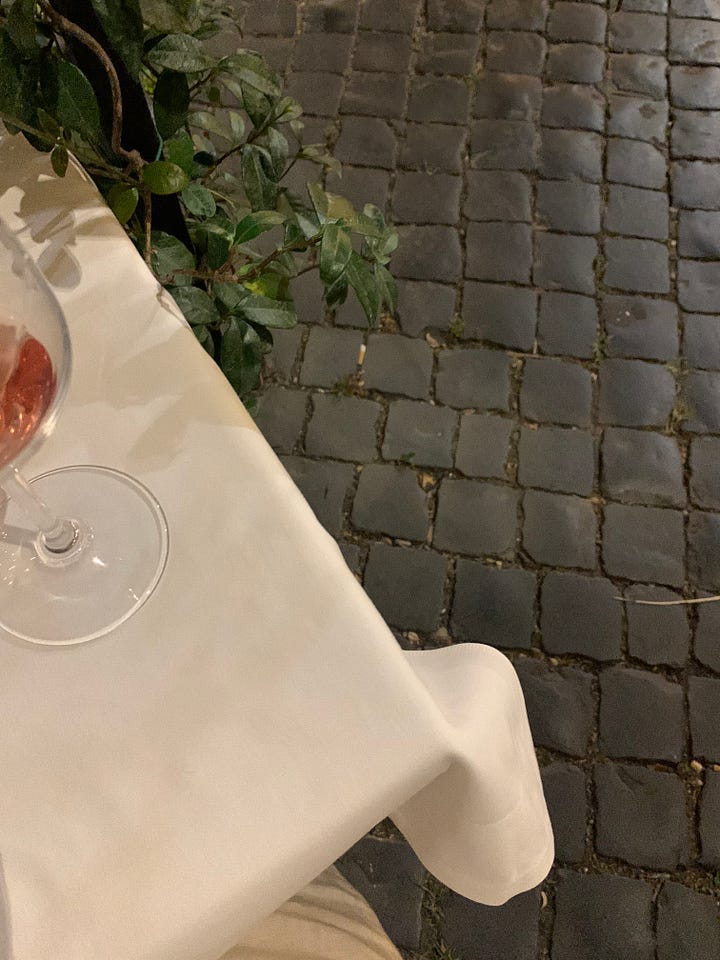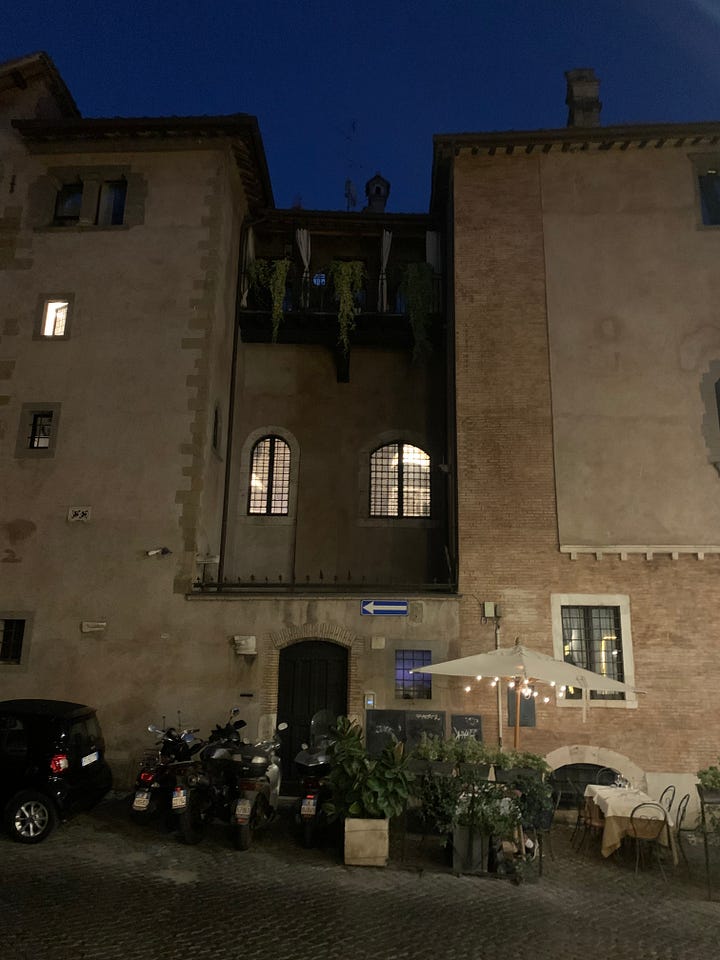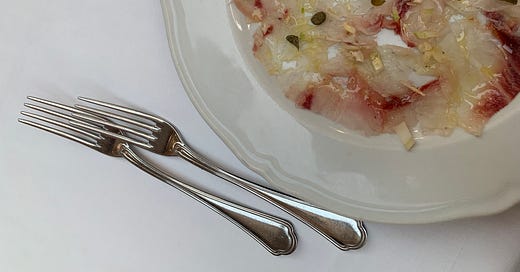This is the one, I thought, about each successive restaurant, me being who I am in Rome and Roman restaurants being what they are. I was certain I would write about la Tavernaccia da Bruno: a little further south in Trastevere, on a block I’d never walked, between the train station and the river. -accia. Ugly suffix. That is to say, the suffix for “ugly.” A joke, of course. It is not ugly, but it also doesn’t care for vanities: a stone arch, a wagon wheel, a cluster of bottles, these are the decorations. I thought I would write about it because it was my first dinner in Rome and I was in a bad mood—I had a headache, was dehydrated from the plane, had been up since 4:30am. I’d misremembered the Airbnb address and walked an extra six blocks, which means a lot more when it’s 100° Fahrenheit. I was in a bad mood when I walked in and less so when I walked out, which means a lot more when I have been up since 4:30am and it’s it’s 100° Fahrenheit. Gricia more pork than anything, tangled cicoria, un mezzo litro that they left off the bill. I left an extra €5 in case the wine was an accident, but it wasn’t. I asked about fruit and the waiter brought a massive wedge of watermelon. “It’s mostly water,” he said. A wink on the side. Watermelon in Italian has a beautiful name: cocomero. It’s related to the word “cucumber,” a cousin, but it always sounded to me like a coconut by the seaside, a thirst quenched on a hot day.
I thought I would write about Hostaria da Pietro, around the corner from del Popolo on an alley that looks like nothing but has the most grand name, Via de Gesù e Maria. The church is at the end of the block. The first time I ate here, it was lunch, late, and men were ordering steak in back rooms, maybe they’d come from church, and we ordered the most grand verdure from a waiter who hummed muted approval: carciofi alla romana, tiny green tomatoes, flat beans with a lemon, cicoria barely wafted with garlic. I was alone this time, and spring was further gone, so only the cicoria, almost the texture of pasta, creamy but with heft. Cacio e pepe, fresh tonnarelli; the meaning of al dente, a large pepper grinder delivered silently to the table. The staff at da Pietro are gentleman waiters, all with moustaches, crisp aprons. Men of few words and one hand behind the back. Men walking swiftly past, somewhere to be. There is a Sorrento lemon behind the bar, half-zested. There is a pot of fresh basil on the credenza; there is a waiter picking leaves carefully and arranging them on the lasagna before whisking it away.
I did not think I would write about Roscioli, obviously, because it’s been written and rewritten already, and because the sole reason I would recommend it is that they know their way around salumi, and what more is there really to write about that? I ordered the all’amatriciana alone at the bar with a glass from Friuli and met a man about to join the priesthood, the man sitting next to me. We shared the mortadella, each slice the size of one of those serum-soaked masks you drape over your face before bed. Just as moist, good for the skin. I asked why he was drawn to it, the priesthood, I mean, and he said he had little choice in the matter. He was drawn. Grazie a Dio. It’s really the guanciale, though, crunchy but gummy, like a cube of condensed pork floss, like candy. Rendered to hell. (Forgive me, father.) The best I ever had, the first time, and better still the last. Drawn, maybe. I am thinking about the feeling of trying to stretch out the last few rigatoni and discovering that there is guanciale still within, hidden, a motherlode, a diamond in the rough, a pearl in the oyster, a pea pulled from under the mattress, a rich mixed metaphor, grazie a Dio. I will live another day on that feeling alone, but I won’t write about it.
No, the dinner I will write about this time is my last in Rome. A little neighborhood place, in Trastevere, mostly locals. I’m writing for the antipasto, a carpaccio of rocciola—amberjack—creamy-white petals dipped in the color of blood orange. Olive oil, capers, a few flecks of celery. And I’m writing for the salad, a salad I’d seen before, one that’s launched a thousand Midwestern pizza parlors. Romaine, carrot, tomato, red wine vinegar, a rough chop, an eye-talian salad (as my grandmother would say) taken as close to perfection as is possible here on earth: carrots sweet and tender, tomatoes savory and bright, tiny leaves of fresh dill, thyme, and oregano, plucked by hand, dusted over every surface. Sampietrini under my feet, parked Vespas piled up against the wall. A glass of rosato, an ink-blue sky, and me.
And yes, the carbonara is carbonara, with Felicetti pasta, an oddly good thing for a sweaty night, electrolytes and slurp. But when I come back to La Gensola—and I will—and it’s the only one of these restaurants for which I am certain of this, for reasons unknown even to me—knowledge that you have despite yourself—when I come back to La Gensola, and sit outside under the windows and brick—when I come back, when I come back—it will not be for the carbonara. Everywhere has carbonara. When I come back, it will be for the knife cuts, the care, the tiniest things—flecks of celery, fine herbs, rosato, sky, and me.




would order again: carpaccio di rocciola, spaghettoni alla carbonara, insalata mista con erbe aromatiche







